quiz_acids and bases
4 likes1,043 views
The document provides instructions for a 15 question true/false and multiple choice test on acids and bases. It explains that each question should be answered honestly by selecting the best answer, and that explanations will be provided for each question after it is answered. It also provides directions on how to navigate between questions and pages of the test.
1 of 33
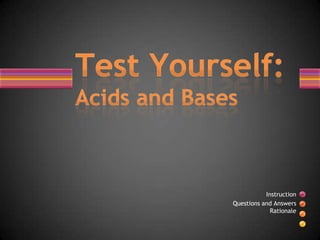
![Instruction
• There are 15 questions provided.
• The questions are in a TRUE or FALSE and Multiple Choice
type of test.
• Choose the BEST answer of each question. Just click the
word/s or letter of your desired answer.
• After each question, an explanation is given to aid
understanding. Click the icon [ ].
• To return, click . Click to proceed to the next page.
• Answer HONESTLY.](https://image.slidesharecdn.com/interactivetestveraque-120928180240-phpapp02/85/quiz_acids-and-bases-2-320.jpg)

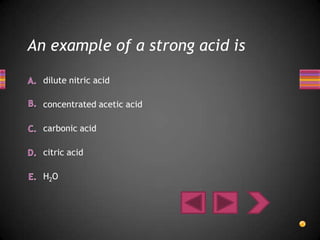
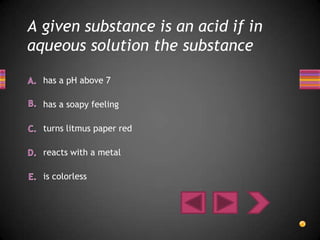
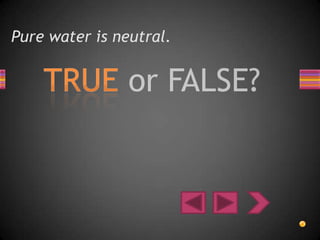
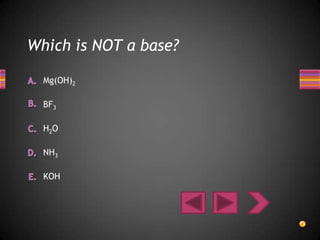
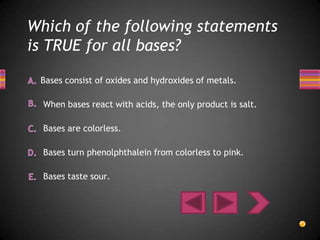
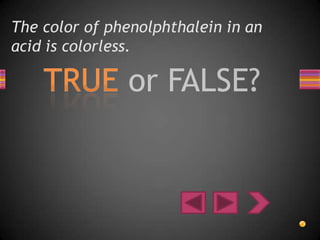
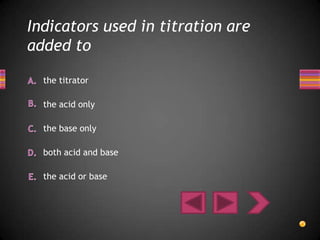
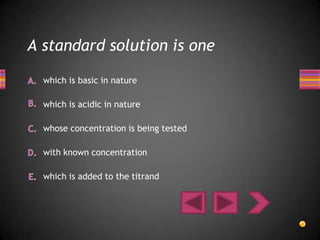

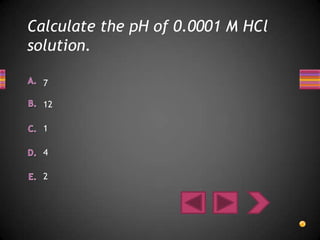
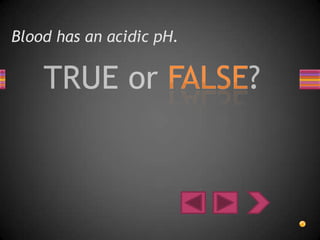
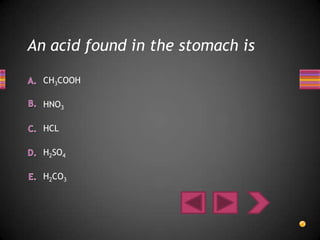
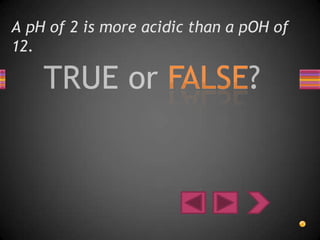
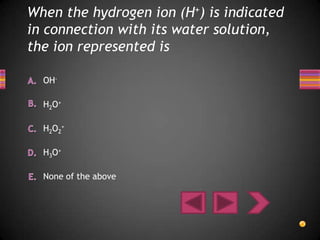

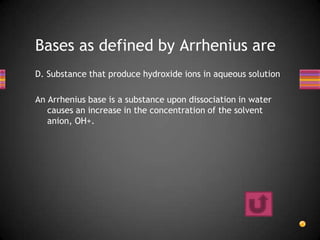
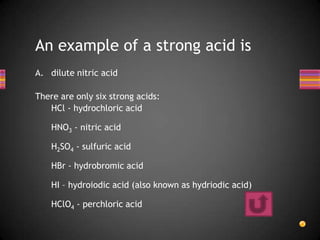
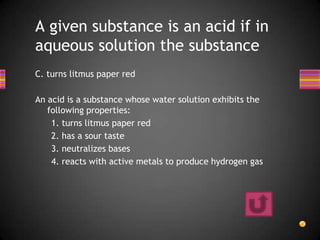
![Pure water is neutral.
TRUE
In pure water, (H3O+) or more often represented as [H+], is
1.0x10-7 M, and the [OH-] is also 1.0x10-7 M. since [H+] is
equal to [OH-], then water is considered neutral.](https://image.slidesharecdn.com/interactivetestveraque-120928180240-phpapp02/85/quiz_acids-and-bases-22-320.jpg)
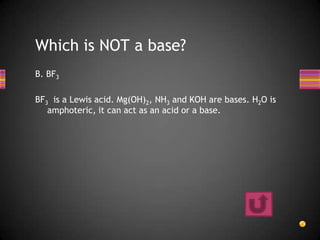
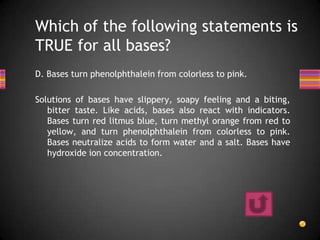
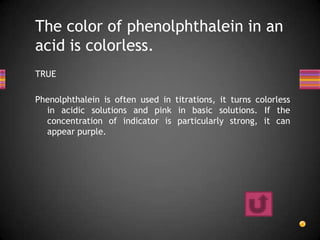

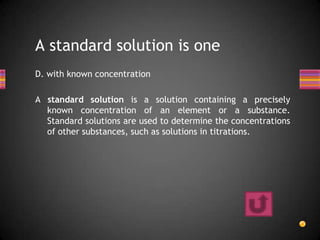
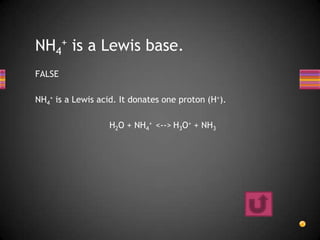
![Calculate the pH of 0.0001 M HCl
solution.
D. 4
Given:
[H+] = 0.0001 M
[H+] = 10-4
Solution:
pH = - log [10-4]
pH = - (-4)
pH = 4](https://image.slidesharecdn.com/interactivetestveraque-120928180240-phpapp02/85/quiz_acids-and-bases-29-320.jpg)
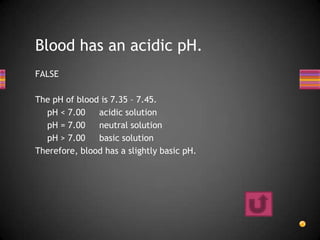
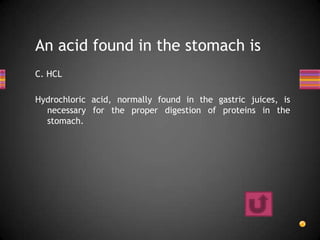
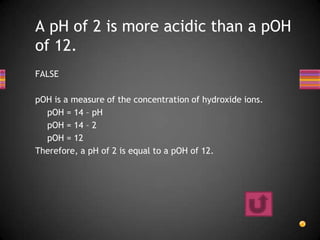
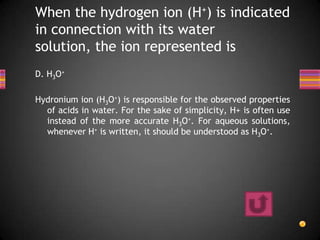
Ad
Recommended
Heat of combustion of Various Alcohols
Heat of combustion of Various Alcoholssweemoi khor
Ã˝
The document defines the heat of combustion as the heat released when one mole of a substance is burned in excess oxygen, exemplified by the combustion of propane. It presents a method for measuring the heat of combustion of various alcohols, detailing the relationship between the number of carbon atoms in the alcohol and the heat released. It also provides the molar masses and heat of combustion values for different alcohols, indicating a trend that higher carbon content correlates with greater heat release.Qualitative analysis of salts
Qualitative analysis of saltsSiti Alias
Ã˝
Qualitative analysis of salts involves conducting a series of tests on an unknown chemical substance to identify the cation and anion present. Common tests include observing the color of the salt, its solubility in water, the effect of heating, and flame tests to determine ions like sodium or calcium. Additional confirmatory tests help identify the specific cation and anion through observing reactions with gases or changes from heating different salt types.Determination of strength of acids and bases by using pH scale
Determination of strength of acids and bases by using pH scaleVeenuGupta8
Ã˝
The document discusses the pH scale and importance of pH in various contexts. It begins by explaining the pH scale ranges from 0-14, with 7 being neutral. Solutions below 7 are acidic and above 7 are basic. It then discusses how pH is important biologically, as the human body and most living things can only survive within a narrow pH range. Other areas discussed where pH is important include agriculture, medicine, preventing milk and tooth spoilage, and some animals' and plants' self-defense mechanisms rely on releasing acidic substances.Heavy metals
Heavy metalsDamodar Koirala
Ã˝
The document provides information about copper (Cu) and its compounds. It discusses the occurrence, extraction, physical and chemical properties, uses, and preparation and properties of some copper compounds like CuO, Cu2O, and CuSO4.5H2O. Copper occurs naturally in the form of copper pyrite and other ores. It is extracted from its ore by crushing, concentration, roasting and smelting processes. Copper has a red color and is ductile and malleable. It reacts with acids, bases, and other reagents. Its common uses include making coins, wires, and pipes.Acid and base
Acid and baseJimnaira Abanto
Ã˝
Acids produce H+ ions in water and taste sour, while bases produce OH- ions in water and taste bitter. Acids react with metals to produce hydrogen gas and with bases to form salts and water. The pH scale ranges from 0-14 and is used to measure whether a substance is acidic (below 7) or basic (above 7). Common indicators like litmus paper and the pH scale can be used to identify substances as acidic or basic. Maintaining the proper pH is important for processes like food preservation, plant growth, and human bodily functions.Carboxylic Acid & Their Derivatives
Carboxylic Acid & Their DerivativesM.T.H Group
Ã˝
This document provides information about carboxylic acids and their derivatives. It begins by stating the learning outcomes, which are to provide nomenclature of carboxylic acids and derivatives, describe physical properties of carboxylic acids, and explain the synthesis and reactions of carboxylic acids and derivatives. The document then discusses the structure, naming rules, physical properties, acid strength, and synthesis methods of carboxylic acids. It also explains the nomenclature and reactions of common carboxylic acid derivatives like esters, acid halides, anhydrides, and amides.55 conservation text
55 conservation textAdarsh Khiloji
Ã˝
This document summarizes key concepts from Chapter 55 of Biology, Seventh Edition regarding conservation biology and restoration ecology. It discusses how conservation biology aims to conserve biodiversity by integrating various fields of study. It also explains how restoration ecology applies ecological principles to return degraded ecosystems to more natural states. The document then covers threats to biodiversity like habitat destruction and introduced species, as well as approaches to conserving populations, landscapes, and ecosystems.Chemistry confirmantory test for IRON II , IRON III , LEAD , AMMONIUM.
Chemistry confirmantory test for IRON II , IRON III , LEAD , AMMONIUM. UTM, MALAYSIA
Ã˝
This document describes confirmatory tests for several metal ions and ammonium ion. Iron(II) ions react with potassium hexacyanoferrate(III) solution to form a dark blue precipitate. Tests for lead(II) ions include using chloride or iodide ions, which form precipitates that dissolve in hot water but reappear in cool water. Ammonium ion can be tested by heating with an alkali to produce ammonia gas, or using Nessler's reagent to form a brown precipitate. Confirmatory tests are summarized along with expected observations and conclusions.ACIDS and BASES.
ACIDS and BASES.Analiza Secillano
Ã˝
The document outlines the properties, characteristics, and behaviors of acids and bases, including their definitions and examples. It explains the pH scale, acid-base indicators, and the process of neutralization, highlighting how acids and bases interact in various chemical reactions. Additionally, it emphasizes the importance of safe testing methods due to the potential hazards of acids and bases.Chapter 3 ketone
Chapter 3 ketoneMiza Kamaruzzaman
Ã˝
Here are the answers:
a)
i) K (2-methyl-1-propanol):
CH3
|
CH3-C-CH2-CH2-OH
|
CH3
L (2-methyl-2-propanol):
CH3
|
CH3-C-CH(OH)-CH3
ii) K can be prepared by reacting propanone with methylmagnesium bromide, a Grignard reagent:
CH3COCH3 + CH3MgBr ‚Üí CH3C(OCH3)(CH3) ‚Üí CH3C(OH)(CH3)CH3 + MgBr
iii) MLss acids and alkalis
Lss acids and alkalisJacklyn Kong
Ã˝
The document describes acids and alkalis. It defines acids as substances that produce hydrogen ions in water and alkalis as substances that produce hydroxide ions in water. Examples of common acids and alkalis are provided. Key chemical properties of acids and alkalis such as their reactions with metals, carbonates, and each other are outlined. The document also discusses pH, indicators, and some applications of acids and alkalis in daily life.C05 the mole concept
C05 the mole conceptdean dundas
Ã˝
This document provides an overview of key concepts related to the mole concept in chemistry. It defines the mole as the number of atoms or molecules in 1 gram of hydrogen or 12 grams of carbon. The mole concept allows chemists to relate mass, number of particles, and volume of gases. It discusses how to calculate empirical and molecular formulas, Avogadro's constant, molar mass, limiting reactants, and other mole-related calculations and applications. Worked examples are provided to demonstrate how to use the mole concept to find formulas of compounds from percentage composition data and other information.benzene
benzeneAyesha Aftab
Ã˝
Benzene is the simplest aromatic hydrocarbon, containing a six-carbon ring with alternating single and double bonds. Unlike other unsaturated hydrocarbons, benzene does not readily undergo addition reactions. The aromatic properties of benzene and related compounds were established through the work of numerous scientists in the 19th and early 20th centuries, including Hofmann, Kekulé, Thomson, Robinson, and Hückel. Friedel-Crafts reactions involve alkylating or acylating aromatic rings using a Lewis acid catalyst. Polycyclic aromatic hydrocarbons consist of multiple fused benzene rings and are common combustion byproducts and pollutants found in cigarette smoke, styrofoam, gasoline, and other sourcesHf overview
Hf overviewladdha1962
Ã˝
HF is a weak acid that is highly corrosive and toxic. It is used in many industrial processes but can cause severe burns upon contact. While initially painless, HF burns penetrate deeply and cause tissue damage through depletion of calcium and magnesium ions. This can lead to systemic effects like hypocalcemia and cardiac issues. Proper decontamination and treatment of HF exposure is important to prevent serious injury.CHE201 LEC 13_NROjghgcdyufiufdyufiuugiuy
CHE201 LEC 13_NROjghgcdyufiufdyufiuugiuyisraksiam311
Ã˝
In the late 1800s, Svante Arrhenius proposed definitions for acids and bases, describing acids as substances that release hydrogen ions (H+) in water and bases as those that release hydroxide ions (OH-). Later, the Br√∏nsted-Lowry theory expanded on Arrhenius' definitions by defining acids as proton donors and bases as proton acceptors, while G.N. Lewis further generalized the concept to include electron pair donation and acceptance. The document also outlines the differences between strong and weak acids and bases as well as the pH scale, which measures the acidity and basicity of solutions.Acids-bases-salts-VG.ppt
Acids-bases-salts-VG.pptssuser329ea9
Ã˝
The document discusses acids, bases, and salts. It provides information on the Arrhenius and Bronsted-Lowry theories of acids and bases. Key points include: Arrhenius acids contain H+ ions and bases contain OH- ions. Bronsted-Lowry defined acids as proton donors and bases as proton acceptors. Acids have a pH below 7 while bases are above 7. Neutralization reactions involve acids and bases reacting to form water and a salt. Titration can be used to determine the concentration of an unknown acid or base solution.Ainun dan winda
Ainun dan windaPaarief Udin
Ã˝
This document discusses acid-base theories and properties of acids and bases. It begins by explaining several theories of acids and bases:
1. Arrhenius theory defines acids as compounds producing H+ ions in water and bases as compounds producing OH- ions.
2. Bronsted-Lowry theory defines acids as proton donors and bases as proton acceptors.
3. Lewis theory defines acids as electron pair acceptors and bases as electron pair donors.
It then discusses the properties of acids and bases, including their behavior in water and reactions with metals. The document also explains concepts like pH, acid and base strength, and the relationship between acid and conjugate base dissociation constants.Ainun dan winda
Ainun dan windaPaarief Udin
Ã˝
This document discusses acid-base theories and properties of acids and bases. It begins by explaining several theories of acids and bases:
1. Arrhenius theory defines acids as compounds producing H+ ions in water and bases as compounds producing OH- ions.
2. Bronsted-Lowry theory defines acids as proton donors and bases as proton acceptors.
3. Lewis theory defines acids as electron pair acceptors and bases as electron pair donors.
It then discusses the properties of acids and bases, including their behavior in water and reactions with metals. The document also explains concepts like pH, acid and base strength, and the relationship between acid and conjugate base dissociation constants.Definitions and MCQs of Ninth class chemistry (acids, bases and salts)
Definitions and MCQs of Ninth class chemistry (acids, bases and salts)Dr. Sajid Ali Talpur
Ã˝
This document contains definitions and multiple choice questions about acids, bases and salts. It defines acids as compounds that can donate protons, bases as those that can accept protons or donate electron pairs, and salts as ionic compounds formed from the neutralization of acids and bases. It also discusses several theories of acids and bases, indicators, buffers, neutralization and pH. The document concludes with 36 multiple choice questions testing understanding of these concepts.Chemistry - Chp 19 - Acids, Bases, and Salt - PowerPoints
Chemistry - Chp 19 - Acids, Bases, and Salt - PowerPointsMel Anthony Pepito
Ã˝
This document provides an overview of acids and bases including:
1) It defines acids and bases according to Arrhenius, Br√∏nsted-Lowry, and Lewis theories and compares their properties.
2) It explains how hydrogen and hydroxide ion concentrations determine if a solution is neutral, acidic, or basic and how pH and pOH scales relate to these concentrations.
3) It describes how acid strength relates to acid dissociation constants and distinguishes between strong and weak acids.Chapter 16 Powerpoint - student version.ppt
Chapter 16 Powerpoint - student version.pptKimberlyAnnePagdanga1
Ã˝
This document discusses acid-base equilibria and the key concepts of acids, bases, pH and pOH. It begins with a review of the Arrhenius and Br√∏nsted-Lowry definitions of acids and bases. Key points covered include: water can act as both an acid and a base; conjugate acid-base pairs are formed in acid-base reactions; and the pH scale relates hydrogen ion concentration to acidity. Strong acids and bases are defined as completely dissociating in water.Chapter 4 Modern Theories of Acid and bases.pdf
Chapter 4 Modern Theories of Acid and bases.pdfhferdous426
Ã˝
For a species to act as a Br√∏nsted base, it must be able to accept a proton (H+) from an acid in a chemical reaction. Atoms that possess a lone pair of electrons are able to accept the proton through formation of a new covalent bond between the proton and the atom with the lone pair. The lone pair provides the electrons needed to form this new bond, allowing the atom to take on the proton and act as a base according to Br√∏nsted-Lowry theory. Therefore, the presence of a lone pair of electrons on an atom in a species is necessary for that species to function as a Br√∏nsted base.ACIDS AND BASES.pptx
ACIDS AND BASES.pptxnona wayne dela pena
Ã˝
1) Acids release hydrogen ions (H+) in water, turning litmus paper red and having a sour taste, while bases release hydroxide ions (OH-), turning litmus blue and having a bitter taste.
2) The pH scale measures the acidity or alkalinity of solutions, with values from 0-7 being acidic, 7 being neutral, and 7-14 being alkaline. Strong acids and bases fully dissociate in water while weak acids and bases only partially dissociate.
3) Acid-base indicators change color depending on the pH, allowing identification of acids and bases. Litmus is commonly used, turning red in acids and blue in bases. Neutralization occursChemistry - Chp 19 - Acids, Bases, and Salt - PowerPoints
Chemistry - Chp 19 - Acids, Bases, and Salt - PowerPointsMr. Walajtys
Ã˝
This document provides an overview of acids and bases according to different theories:
1. Arrhenius theory defines acids as producing hydrogen ions in water and bases as producing hydroxide ions.
2. Br√∏nsted-Lowry theory defines acids as hydrogen ion donors and bases as hydrogen ion acceptors.
3. Lewis theory focuses on electron pair donation and acceptance between reactants.
It also discusses the pH scale, ion product constant of water, and using indicators to determine if a solution is acidic, basic, or neutral.Acids, Bases, and pH2.pdfjejejejjejejeeeue
Acids, Bases, and pH2.pdfjejejejjejejeeeueichigokurasaki004
Ã˝
This document provides an overview of acids and bases, detailing their characteristics, definitions, and how they interact in water. It explains the differences between strong and weak acids and bases, introduces the pH scale as a measure of acidity and basicity, and defines neutral solutions. Additionally, the document highlights common acids and bases and their importance in various processes.Acid base information in daily life of people,the theory regarding it in scie...
Acid base information in daily life of people,the theory regarding it in scie...JayeshChavarkar
Ã˝
This document discusses acids, bases, and salts. It covers the key properties of acids and bases, as well as three major theories of acids and bases: Arrhenius, Bronsted-Lowry, and Lewis. It also discusses acid and base strength in terms of acid dissociation constants, as well as neutralization reactions between acids and bases and the use of titrations.Quiz Acids And Bases 5
Quiz Acids And Bases 5guest53e1dff
Ã˝
This document provides information about acids and bases, including:
1. Identifying properties of acids and bases such as tasting sour, feeling slippery, turning litmus paper red/blue, and reacting with metals or carbonates.
2. Classifying common substances as acids or bases such as HCl, NaOH, H2SO4.
3. Classifying acids and bases as strong or weak such as HCl (strong acid) and acetic acid (weak acid), NaOH (strong base) and NH3 (weak base).
4. Storing acids in glass rather than metal containers due to corrosion. Never testing acids or bases by taste or on skin due to harm.Quiz Acids And Bases 5
Quiz Acids And Bases 5guest51d6d6
Ã˝
This document provides information about acids and bases, including:
1. Identifying properties of acids and bases such as tasting sour, feeling slippery, turning litmus paper red/blue, and reacting with metals to produce hydrogen gas.
2. Classifying common acids and bases such as HCl, NaOH, H2SO4 as acids or bases.
3. Identifying strong acids like HCl as strong acids and weak acids like HC2H3O2 as weak acids.
4. Noting that people store acids in glass containers rather than metal containers for safety reasons.Acids, bases, and p h2
Acids, bases, and p h2Tabassum Sabir
Ã˝
1. Acids donate hydrogen ions in water, forming hydronium ions, and have characteristics like turning litmus paper red and tasting sour. Bases form hydroxide ions in water and have opposite characteristics.
2. The pH scale measures how acidic or basic a substance is based on its hydronium ion concentration, with values from 0-14. More acidic substances have fewer hydronium ions and lower pH values closer to 0.
3. A substance is neutral when it has equal concentrations of hydronium and hydroxide ions, resulting in a pH of 7.22 acids + bases
22 acids + basesmrtangextrahelp
Ã˝
The document discusses the key properties and reactions of acids and bases. It defines acids as substances that produce hydrogen ions (H+) in water and bases as substances that produce hydroxide ions (OH-). Acids react with metals, carbonates, conduct electricity, turn litmus paper red, and neutralize bases. Bases conduct electricity, turn litmus paper blue, and neutralize acids. Theories of acids and bases including Arrhenius, Br√∏nsted-Lowry, and Lewis are explained. Strong and weak acids/bases, monoprotic/diprotic/triprotic acids, pH, titrations, and acid-base indicators are also covered.More Related Content
What's hot (6)
ACIDS and BASES.
ACIDS and BASES.Analiza Secillano
Ã˝
The document outlines the properties, characteristics, and behaviors of acids and bases, including their definitions and examples. It explains the pH scale, acid-base indicators, and the process of neutralization, highlighting how acids and bases interact in various chemical reactions. Additionally, it emphasizes the importance of safe testing methods due to the potential hazards of acids and bases.Chapter 3 ketone
Chapter 3 ketoneMiza Kamaruzzaman
Ã˝
Here are the answers:
a)
i) K (2-methyl-1-propanol):
CH3
|
CH3-C-CH2-CH2-OH
|
CH3
L (2-methyl-2-propanol):
CH3
|
CH3-C-CH(OH)-CH3
ii) K can be prepared by reacting propanone with methylmagnesium bromide, a Grignard reagent:
CH3COCH3 + CH3MgBr ‚Üí CH3C(OCH3)(CH3) ‚Üí CH3C(OH)(CH3)CH3 + MgBr
iii) MLss acids and alkalis
Lss acids and alkalisJacklyn Kong
Ã˝
The document describes acids and alkalis. It defines acids as substances that produce hydrogen ions in water and alkalis as substances that produce hydroxide ions in water. Examples of common acids and alkalis are provided. Key chemical properties of acids and alkalis such as their reactions with metals, carbonates, and each other are outlined. The document also discusses pH, indicators, and some applications of acids and alkalis in daily life.C05 the mole concept
C05 the mole conceptdean dundas
Ã˝
This document provides an overview of key concepts related to the mole concept in chemistry. It defines the mole as the number of atoms or molecules in 1 gram of hydrogen or 12 grams of carbon. The mole concept allows chemists to relate mass, number of particles, and volume of gases. It discusses how to calculate empirical and molecular formulas, Avogadro's constant, molar mass, limiting reactants, and other mole-related calculations and applications. Worked examples are provided to demonstrate how to use the mole concept to find formulas of compounds from percentage composition data and other information.benzene
benzeneAyesha Aftab
Ã˝
Benzene is the simplest aromatic hydrocarbon, containing a six-carbon ring with alternating single and double bonds. Unlike other unsaturated hydrocarbons, benzene does not readily undergo addition reactions. The aromatic properties of benzene and related compounds were established through the work of numerous scientists in the 19th and early 20th centuries, including Hofmann, Kekulé, Thomson, Robinson, and Hückel. Friedel-Crafts reactions involve alkylating or acylating aromatic rings using a Lewis acid catalyst. Polycyclic aromatic hydrocarbons consist of multiple fused benzene rings and are common combustion byproducts and pollutants found in cigarette smoke, styrofoam, gasoline, and other sourcesHf overview
Hf overviewladdha1962
Ã˝
HF is a weak acid that is highly corrosive and toxic. It is used in many industrial processes but can cause severe burns upon contact. While initially painless, HF burns penetrate deeply and cause tissue damage through depletion of calcium and magnesium ions. This can lead to systemic effects like hypocalcemia and cardiac issues. Proper decontamination and treatment of HF exposure is important to prevent serious injury.Similar to quiz_acids and bases (20)
CHE201 LEC 13_NROjghgcdyufiufdyufiuugiuy
CHE201 LEC 13_NROjghgcdyufiufdyufiuugiuyisraksiam311
Ã˝
In the late 1800s, Svante Arrhenius proposed definitions for acids and bases, describing acids as substances that release hydrogen ions (H+) in water and bases as those that release hydroxide ions (OH-). Later, the Br√∏nsted-Lowry theory expanded on Arrhenius' definitions by defining acids as proton donors and bases as proton acceptors, while G.N. Lewis further generalized the concept to include electron pair donation and acceptance. The document also outlines the differences between strong and weak acids and bases as well as the pH scale, which measures the acidity and basicity of solutions.Acids-bases-salts-VG.ppt
Acids-bases-salts-VG.pptssuser329ea9
Ã˝
The document discusses acids, bases, and salts. It provides information on the Arrhenius and Bronsted-Lowry theories of acids and bases. Key points include: Arrhenius acids contain H+ ions and bases contain OH- ions. Bronsted-Lowry defined acids as proton donors and bases as proton acceptors. Acids have a pH below 7 while bases are above 7. Neutralization reactions involve acids and bases reacting to form water and a salt. Titration can be used to determine the concentration of an unknown acid or base solution.Ainun dan winda
Ainun dan windaPaarief Udin
Ã˝
This document discusses acid-base theories and properties of acids and bases. It begins by explaining several theories of acids and bases:
1. Arrhenius theory defines acids as compounds producing H+ ions in water and bases as compounds producing OH- ions.
2. Bronsted-Lowry theory defines acids as proton donors and bases as proton acceptors.
3. Lewis theory defines acids as electron pair acceptors and bases as electron pair donors.
It then discusses the properties of acids and bases, including their behavior in water and reactions with metals. The document also explains concepts like pH, acid and base strength, and the relationship between acid and conjugate base dissociation constants.Ainun dan winda
Ainun dan windaPaarief Udin
Ã˝
This document discusses acid-base theories and properties of acids and bases. It begins by explaining several theories of acids and bases:
1. Arrhenius theory defines acids as compounds producing H+ ions in water and bases as compounds producing OH- ions.
2. Bronsted-Lowry theory defines acids as proton donors and bases as proton acceptors.
3. Lewis theory defines acids as electron pair acceptors and bases as electron pair donors.
It then discusses the properties of acids and bases, including their behavior in water and reactions with metals. The document also explains concepts like pH, acid and base strength, and the relationship between acid and conjugate base dissociation constants.Definitions and MCQs of Ninth class chemistry (acids, bases and salts)
Definitions and MCQs of Ninth class chemistry (acids, bases and salts)Dr. Sajid Ali Talpur
Ã˝
This document contains definitions and multiple choice questions about acids, bases and salts. It defines acids as compounds that can donate protons, bases as those that can accept protons or donate electron pairs, and salts as ionic compounds formed from the neutralization of acids and bases. It also discusses several theories of acids and bases, indicators, buffers, neutralization and pH. The document concludes with 36 multiple choice questions testing understanding of these concepts.Chemistry - Chp 19 - Acids, Bases, and Salt - PowerPoints
Chemistry - Chp 19 - Acids, Bases, and Salt - PowerPointsMel Anthony Pepito
Ã˝
This document provides an overview of acids and bases including:
1) It defines acids and bases according to Arrhenius, Br√∏nsted-Lowry, and Lewis theories and compares their properties.
2) It explains how hydrogen and hydroxide ion concentrations determine if a solution is neutral, acidic, or basic and how pH and pOH scales relate to these concentrations.
3) It describes how acid strength relates to acid dissociation constants and distinguishes between strong and weak acids.Chapter 16 Powerpoint - student version.ppt
Chapter 16 Powerpoint - student version.pptKimberlyAnnePagdanga1
Ã˝
This document discusses acid-base equilibria and the key concepts of acids, bases, pH and pOH. It begins with a review of the Arrhenius and Br√∏nsted-Lowry definitions of acids and bases. Key points covered include: water can act as both an acid and a base; conjugate acid-base pairs are formed in acid-base reactions; and the pH scale relates hydrogen ion concentration to acidity. Strong acids and bases are defined as completely dissociating in water.Chapter 4 Modern Theories of Acid and bases.pdf
Chapter 4 Modern Theories of Acid and bases.pdfhferdous426
Ã˝
For a species to act as a Br√∏nsted base, it must be able to accept a proton (H+) from an acid in a chemical reaction. Atoms that possess a lone pair of electrons are able to accept the proton through formation of a new covalent bond between the proton and the atom with the lone pair. The lone pair provides the electrons needed to form this new bond, allowing the atom to take on the proton and act as a base according to Br√∏nsted-Lowry theory. Therefore, the presence of a lone pair of electrons on an atom in a species is necessary for that species to function as a Br√∏nsted base.ACIDS AND BASES.pptx
ACIDS AND BASES.pptxnona wayne dela pena
Ã˝
1) Acids release hydrogen ions (H+) in water, turning litmus paper red and having a sour taste, while bases release hydroxide ions (OH-), turning litmus blue and having a bitter taste.
2) The pH scale measures the acidity or alkalinity of solutions, with values from 0-7 being acidic, 7 being neutral, and 7-14 being alkaline. Strong acids and bases fully dissociate in water while weak acids and bases only partially dissociate.
3) Acid-base indicators change color depending on the pH, allowing identification of acids and bases. Litmus is commonly used, turning red in acids and blue in bases. Neutralization occursChemistry - Chp 19 - Acids, Bases, and Salt - PowerPoints
Chemistry - Chp 19 - Acids, Bases, and Salt - PowerPointsMr. Walajtys
Ã˝
This document provides an overview of acids and bases according to different theories:
1. Arrhenius theory defines acids as producing hydrogen ions in water and bases as producing hydroxide ions.
2. Br√∏nsted-Lowry theory defines acids as hydrogen ion donors and bases as hydrogen ion acceptors.
3. Lewis theory focuses on electron pair donation and acceptance between reactants.
It also discusses the pH scale, ion product constant of water, and using indicators to determine if a solution is acidic, basic, or neutral.Acids, Bases, and pH2.pdfjejejejjejejeeeue
Acids, Bases, and pH2.pdfjejejejjejejeeeueichigokurasaki004
Ã˝
This document provides an overview of acids and bases, detailing their characteristics, definitions, and how they interact in water. It explains the differences between strong and weak acids and bases, introduces the pH scale as a measure of acidity and basicity, and defines neutral solutions. Additionally, the document highlights common acids and bases and their importance in various processes.Acid base information in daily life of people,the theory regarding it in scie...
Acid base information in daily life of people,the theory regarding it in scie...JayeshChavarkar
Ã˝
This document discusses acids, bases, and salts. It covers the key properties of acids and bases, as well as three major theories of acids and bases: Arrhenius, Bronsted-Lowry, and Lewis. It also discusses acid and base strength in terms of acid dissociation constants, as well as neutralization reactions between acids and bases and the use of titrations.Quiz Acids And Bases 5
Quiz Acids And Bases 5guest53e1dff
Ã˝
This document provides information about acids and bases, including:
1. Identifying properties of acids and bases such as tasting sour, feeling slippery, turning litmus paper red/blue, and reacting with metals or carbonates.
2. Classifying common substances as acids or bases such as HCl, NaOH, H2SO4.
3. Classifying acids and bases as strong or weak such as HCl (strong acid) and acetic acid (weak acid), NaOH (strong base) and NH3 (weak base).
4. Storing acids in glass rather than metal containers due to corrosion. Never testing acids or bases by taste or on skin due to harm.Quiz Acids And Bases 5
Quiz Acids And Bases 5guest51d6d6
Ã˝
This document provides information about acids and bases, including:
1. Identifying properties of acids and bases such as tasting sour, feeling slippery, turning litmus paper red/blue, and reacting with metals to produce hydrogen gas.
2. Classifying common acids and bases such as HCl, NaOH, H2SO4 as acids or bases.
3. Identifying strong acids like HCl as strong acids and weak acids like HC2H3O2 as weak acids.
4. Noting that people store acids in glass containers rather than metal containers for safety reasons.Acids, bases, and p h2
Acids, bases, and p h2Tabassum Sabir
Ã˝
1. Acids donate hydrogen ions in water, forming hydronium ions, and have characteristics like turning litmus paper red and tasting sour. Bases form hydroxide ions in water and have opposite characteristics.
2. The pH scale measures how acidic or basic a substance is based on its hydronium ion concentration, with values from 0-14. More acidic substances have fewer hydronium ions and lower pH values closer to 0.
3. A substance is neutral when it has equal concentrations of hydronium and hydroxide ions, resulting in a pH of 7.22 acids + bases
22 acids + basesmrtangextrahelp
Ã˝
The document discusses the key properties and reactions of acids and bases. It defines acids as substances that produce hydrogen ions (H+) in water and bases as substances that produce hydroxide ions (OH-). Acids react with metals, carbonates, conduct electricity, turn litmus paper red, and neutralize bases. Bases conduct electricity, turn litmus paper blue, and neutralize acids. Theories of acids and bases including Arrhenius, Br√∏nsted-Lowry, and Lewis are explained. Strong and weak acids/bases, monoprotic/diprotic/triprotic acids, pH, titrations, and acid-base indicators are also covered.Acids, Bases, and pH2.ppt
Acids, Bases, and pH2.pptErgiHoxha3
Ã˝
1. Acids donate hydrogen ions in water, forming hydronium ions, and have characteristics like turning litmus paper red and tasting sour. Bases form hydroxide ions in water and have opposite characteristics.
2. The pH scale measures how acidic or basic a substance is based on its hydronium ion concentration, with values from 0-14. More acidic substances have fewer hydronium ions and lower pH values closer to 0.
3. A substance is neutral when it has equal concentrations of hydronium and hydroxide ions, resulting in a pH of 7.3.3 Acids and Bases
3.3 Acids and BasesMelinda MacDonald
Ã˝
The pink colour in test tubes #2 and #4 was caused by the basic solution (NaOH) reacting with the phenolphthalein indicator, which turns pink in basic solutions with a pH between 8.2-12.
The colour disappeared in test tube #5 because the acidic solution (HCl) was added, and phenolphthalein is colourless in acidic solutions below pH 8.2.
We could use an acidic solution like HCl to take away the pink colour in test tube #6, as it would neutralize the basic solution and lower the pH below 8.2, making the phenolphthalein colourless again.doFGHFHTRHJTRYTRJYLIOYUJTDHRTRwnload.pdf
doFGHFHTRHJTRYTRJYLIOYUJTDHRTRwnload.pdfRahul Radhakrishnan
Ã˝
Acids produce hydrogen ions (H+) in water and bases produce hydroxide ions (OH-). Common acids include hydrochloric acid, sulfuric acid, and nitric acid. Common bases include sodium hydroxide and potassium hydroxide. Acids and bases react through a neutralization reaction where hydrogen ions and hydroxide ions combine to form water and a salt. Indicators are used to determine if a substance is an acid or base by changing color in their presence.Acids_&_Bases_Notes.pdfbbhrtyhytttyhuy44rtg
Acids_&_Bases_Notes.pdfbbhrtyhytttyhuy44rtghalegaye256
Ã˝
The document discusses the properties and behaviors of acids and bases according to both Arrhenius and Lowry-Br√∏nsted theories, highlighting their definitions, reactions, and the concept of neutralization. It explains the pH scale, the role of indicators, and provides practical applications and calculations for determining concentrations during titrations. Additionally, it covers the classification of strong and weak acids and bases, their ionization, and the reactions they undergo with various substances.Ad
More from Insel Lei (6)
ppt_acids and bases
ppt_acids and basesInsel Lei
Ã˝
The document discusses pH and ways of measuring pH. It defines pH as a measure of hydrogen ion activity and notes that pure water has a pH close to 7. It describes the pH scale from 0 to 14 and mentions that pH is measured using indicators, glass electrodes, or titration. Key methods include using indicators to compare colors, and glass electrode methods which are most widely used due to speed, reproducibility, and applicability to various solutions.Unit template
Unit templateInsel Lei
Ã˝
This unit plan focuses on teaching students about matter. The unit will last 5 days and include both classroom and laboratory activities. Students will learn about the states of matter, properties of matter, and how matter can change. They will distinguish between mixtures and pure substances. Assessment will include a research paper, group presentations, essays, creative presentations, laboratory reports, and a unit test. The goal is for students to understand the classification and behavior of matter, as well as its importance in daily life.Matter powerpoint
Matter powerpointInsel Lei
Ã˝
The document discusses the diverse properties of matter, including its physical states (solid, liquid, gas, plasma, Bose-Einstein condensate), changes (physical and chemical), and properties (physical and chemical). It also classifies matter into pure substances, elements, compounds, and mixtures. The essence of matter is linked to the concept of extension and thought, as noted by René Descartes.Matter Powerpoint
Matter PowerpointInsel Lei
Ã˝
The document discusses the diverse properties and physical states of matter, including solids, liquids, gases, and plasma. It outlines various changes matter undergoes, such as physical and chemical changes, and categorizes matter into pure substances and mixtures. The philosophical notion of substance is also referenced, relating to the nature of physical and mental entities.Philippine curriculum_elem2010
Philippine curriculum_elem2010Insel Lei
Ã˝
The document discusses the Philippine curriculum and education system. It notes that education must adapt to rapid changes. The basic education system includes elementary, junior high, and senior high school. It emphasizes developing skills like critical thinking for the 21st century. However, the document argues that values education in the curriculum has not been effective given issues in Philippine society like corruption. It calls for reforming values formation to better overcome these challenges.Philippine curriculum_elementary2010
Philippine curriculum_elementary2010Insel Lei
Ã˝
The document discusses the Philippine curriculum and education system. It notes that education must adapt to rapid changes. The basic education system includes elementary, secondary, and post-secondary levels. Preschool education is being incorporated into basic education. The 2002 revised basic education curriculum emphasizes values education and 21st century skills. However, the education system still struggles with ensuring proper values formation given issues in Philippine society. Reform is needed to improve values education in the curriculum.Ad
quiz_acids and bases
- 1. Instruction Questions and Answers Rationale
- 2. Instruction • There are 15 questions provided. • The questions are in a TRUE or FALSE and Multiple Choice type of test. • Choose the BEST answer of each question. Just click the word/s or letter of your desired answer. • After each question, an explanation is given to aid understanding. Click the icon [ ]. • To return, click . Click to proceed to the next page. • Answer HONESTLY.
- 3. Bases as defined by Arrhenius are Electron pair donors Proton acceptors Substance that produce hydrogen ions in aqueous solution Substance that produce hydroxide ions in aqueous solution All of the above
- 4. An example of a strong acid is dilute nitric acid concentrated acetic acid carbonic acid citric acid H2O
- 5. A given substance is an acid if in aqueous solution the substance has a pH above 7 has a soapy feeling turns litmus paper red reacts with a metal is colorless
- 6. Pure water is neutral.
- 7. Which is NOT a base? Mg(OH)2 BF3 H2O NH3 KOH
- 8. Which of the following statements is TRUE for all bases? Bases consist of oxides and hydroxides of metals. When bases react with acids, the only product is salt. Bases are colorless. Bases turn phenolphthalein from colorless to pink. Bases taste sour.
- 9. The color of phenolphthalein in an acid is colorless.
- 10. Indicators used in titration are added to the titrator the acid only the base only both acid and base the acid or base
- 11. A standard solution is one which is basic in nature which is acidic in nature whose concentration is being tested with known concentration which is added to the titrand
- 12. NH4+ is a Lewis base.
- 13. Calculate the pH of 0.0001 M HCl solution. 7 12 1 4 2
- 14. Blood has an acidic pH.
- 15. An acid found in the stomach is CH3COOH HNO3 HCL H2SO4 H2CO3
- 16. A pH of 2 is more acidic than a pOH of 12.
- 17. When the hydrogen ion (H+) is indicated in connection with its water solution, the ion represented is OH- H2O+ H2O2+ H3O+ None of the above
- 19. Bases as defined by Arrhenius are D. Substance that produce hydroxide ions in aqueous solution An Arrhenius base is a substance upon dissociation in water causes an increase in the concentration of the solvent anion, OH+.
- 20. An example of a strong acid is A. dilute nitric acid There are only six strong acids: HCl - hydrochloric acid HNO3 - nitric acid H2SO4 - sulfuric acid HBr - hydrobromic acid HI – hydroiodic acid (also known as hydriodic acid) HClO4 - perchloric acid
- 21. A given substance is an acid if in aqueous solution the substance C. turns litmus paper red An acid is a substance whose water solution exhibits the following properties: 1. turns litmus paper red 2. has a sour taste 3. neutralizes bases 4. reacts with active metals to produce hydrogen gas
- 22. Pure water is neutral. TRUE In pure water, (H3O+) or more often represented as [H+], is 1.0x10-7 M, and the [OH-] is also 1.0x10-7 M. since [H+] is equal to [OH-], then water is considered neutral.
- 23. Which is NOT a base? B. BF3 BF3 is a Lewis acid. Mg(OH)2, NH3 and KOH are bases. H2O is amphoteric, it can act as an acid or a base.
- 24. Which of the following statements is TRUE for all bases? D. Bases turn phenolphthalein from colorless to pink. Solutions of bases have slippery, soapy feeling and a biting, bitter taste. Like acids, bases also react with indicators. Bases turn red litmus blue, turn methyl orange from red to yellow, and turn phenolphthalein from colorless to pink. Bases neutralize acids to form water and a salt. Bases have hydroxide ion concentration.
- 25. The color of phenolphthalein in an acid is colorless. TRUE Phenolphthalein is often used in titrations, it turns colorless in acidic solutions and pink in basic solutions. If the concentration of indicator is particularly strong, it can appear purple.
- 26. Indicators used in titration are added to E. the acid or base An indicator is added to the titrand (either an acid or a base), whose concentration is unknown.
- 27. A standard solution is one D. with known concentration A standard solution is a solution containing a precisely known concentration of an element or a substance. Standard solutions are used to determine the concentrations of other substances, such as solutions in titrations.
- 28. NH4+ is a Lewis base. FALSE NH4+ is a Lewis acid. It donates one proton (H+). H2O + NH4+ <--> H3O+ + NH3
- 29. Calculate the pH of 0.0001 M HCl solution. D. 4 Given: [H+] = 0.0001 M [H+] = 10-4 Solution: pH = - log [10-4] pH = - (-4) pH = 4
- 30. Blood has an acidic pH. FALSE The pH of blood is 7.35 – 7.45. pH < 7.00 acidic solution pH = 7.00 neutral solution pH > 7.00 basic solution Therefore, blood has a slightly basic pH.
- 31. An acid found in the stomach is C. HCL Hydrochloric acid, normally found in the gastric juices, is necessary for the proper digestion of proteins in the stomach.
- 32. A pH of 2 is more acidic than a pOH of 12. FALSE pOH is a measure of the concentration of hydroxide ions. pOH = 14 – pH pOH = 14 – 2 pOH = 12 Therefore, a pH of 2 is equal to a pOH of 12.
- 33. When the hydrogen ion (H+) is indicated in connection with its water solution, the ion represented is D. H3O+ Hydronium ion (H3O+) is responsible for the observed properties of acids in water. For the sake of simplicity, H+ is often use instead of the more accurate H3O+. For aqueous solutions, whenever H+ is written, it should be understood as H3O+.
